Student Learning Objectives
Lessons / Lecture Notes
Important Equations
Example Problems
Applets and Animations
Student Learning Objectives
Lessons / Lecture Notes
The Physics Classroom (conceptual)
PY106 Notes from Boston University (algebra-based):
Physics 2C notes from Dr. Bobby W.S. Lau (algebra-based)
HyperPhysics (calculus-based)
Physics 4C notes from Dr. Bobby W.S. Lau (calculus-based)
Important Equations (for algebra-based Physics)
Example Problems
Example Problems for algebra-based physics (from College Physics 2nd Edition by Knight, Jones, and Field):
Example Problems (Ray Optics)
Solutions to Example Problems (Ray Optics)
Example Problems for calculus-based physics (from Fundamentals of Physics 9th Edition by Halliday, Resnick, and Walker):
Example Problems (Images)
Solutions to Example Problems (Images)
Applets and Animations
| Reflection and Refraction of Light Waves (Huygen's Principle) | This app is a sort of tutorial which explains the reflection and the refraction of waves by the principle of Huygens. Explanations of each of the steps are provided in the text box. Whenever a step is finished, press the "Next step" button! You can stop and continue the simulation by using the "Pause / Resume" button. The three text fields make it possible to vary the index of refraction of both media and the angle of incidence. The medium with the smaller index of refraction (the bigger phase velocity) is painted yellow, the other blue. | |
| Huygen's Principle - Reflection & Refraction | 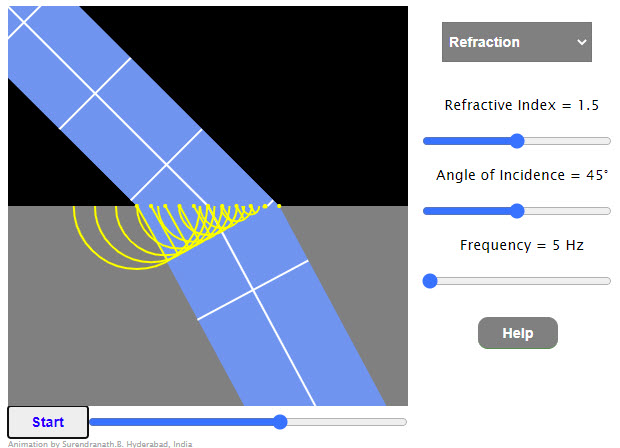 |
Animation shows a plane wavefront being reflected or refracted at a plane boundary. The secondary wave front is shown as it is formed. Click/tap at the left edge to change the mode (single wavefront/multiple wavefronts) Drag at the boundary to change the width of the wavefront. Click/tap anywhere else to change the number of secondary sources. |
| Reflection and Refraction of Light | 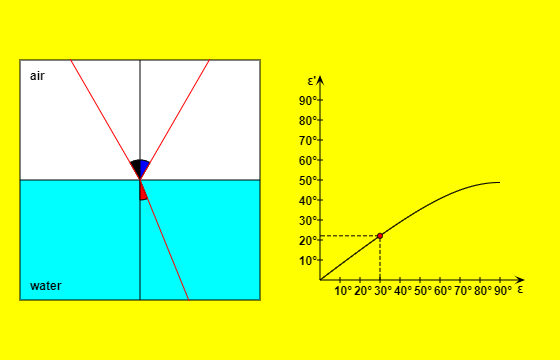 |
A ray of light coming from the top left strikes the boundary surface of two media. (It is possible to choose the substances in both lists.) The medium which has the bigger index of refraction is painted blue, the other yellow. You can vary the incident ray with pressed mouse button. The app will show the reflected and the refracted ray and calculate the corresponding angles: |
| Spherical Mirrors and Lenses | 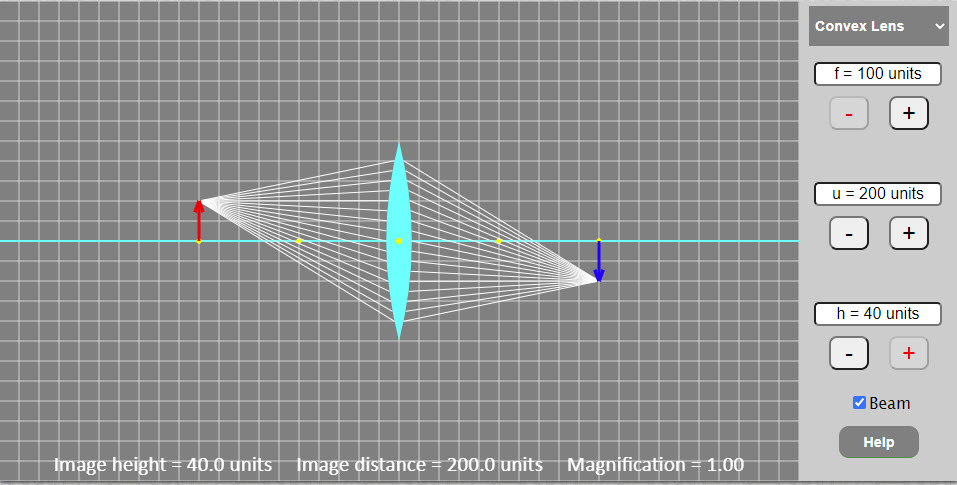 |
A very nice applet showing the image formation by concave and convex mirrors and lenses. |
| Geometric Optics | 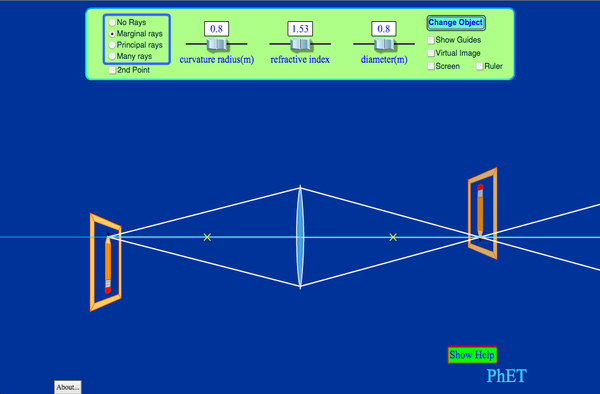 |
How does a lens form an image? See how light rays are refracted by a lens. Watch how the image changes when you adjust the focal length of the lens, move the object, move the lens, or move the screen. |
| Bending Light | Explore bending of light between two media with different indices of refraction. See how changing from air to water to glass changes the bending angle. Play with prisms of different shapes and make rainbows. | |
| Marching Band Model of Refraction | 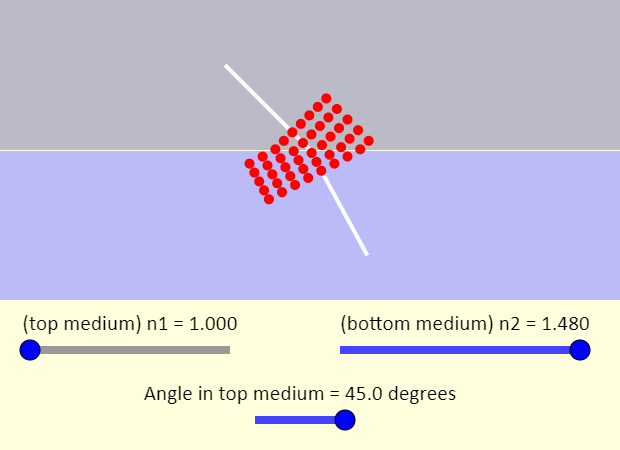 |
This simulation shows a marching band model for refraction. We're looking at an overhead view of five rows of the marching band. When the band moves from one surface (say, a parking lot) to a different surface (say, a grassy field), the speed of the marchers can change. Associated with that change in speed is, often, a change in direction - this happens if different marchers in a particular row reach the second surface at different times. This is an analog of the behavior of light when it travels from one medium to another. The index of refraction of the media can be set with the sliders - the larger the index of refraction, the slower the marchers (the light) travels in that medium. The angle of incidence, measured from the normal (perpendicular to the interface), can also be set with a slider. |
| Refraction |  |
The light source can either be the red dot in medium 1, or the purple dot in medium 2. In either case, the light is incident on the interface between the two media at the position of the green dot, which is fixed. Most of the time, some of the light reflects back into the medium it started in, and some refracts into the other medium. In some cases, however, none of the light enters the second medium - this is true when the angle of incidence exceeds the critical angle. (The critical angle is marked by the angled black lines in one of the media.) In that case, all the light reflects back into the medium it started in - we say that the light experiences total internal reflection. Explore the simulation, adjusting the index of refraction of each medium, moving the light source around, and having the light come from the other medium, to find some general properties of refraction and of total internal reflection. In addition, when the light does refract from medium 1 into medium 2, use the purple dot to mark a point on the beam of light in medium 2. Then, switch the light source to medium 2 - what do you notice about the light that refracts into medium 1? |
| Refraction Block | 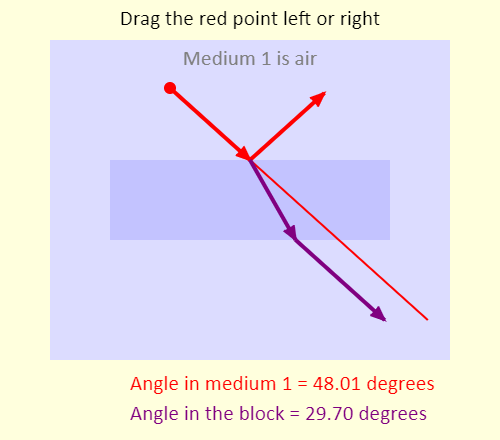 |
The light is emitted by the red dot, which is in air. The light strikes the side of a rectangular block. Some of the light reflects back into the air, and some is transmitted into the block. When the light emerges from the far side of the block, in what direction is the light traveling, compared to the direction the light was going before it hit the block? The red reference line can guide your thinking. Note that you can move the light source left or right, and you can adjust the index of refraction of the block. |
| Refraction - 3 Layers | 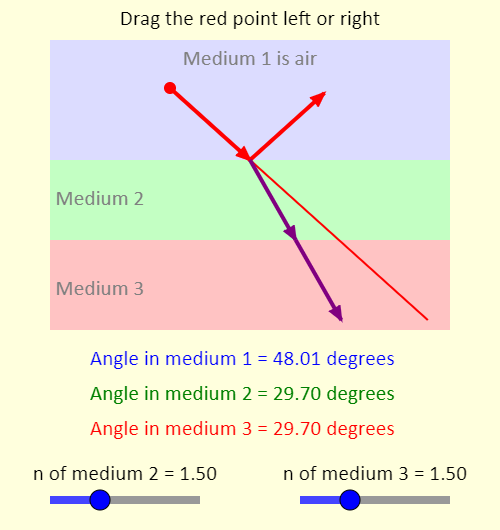 |
The light is emitted by the red dot, which is in air. The light enters medium 2, and then continues on to medium 3. Before adjusting either slider, make two predictions. How will the angle of the light in medium 3 be affected by (1) increasing or decreasing the index of refraction of medium 2? (2) increasing or decreasing the index of refraction of medium 3? Note that you can drag the light source left or right, and you can adjust the index of refraction of medium 2 and medium 3 using the sliders. |
| Refraction | 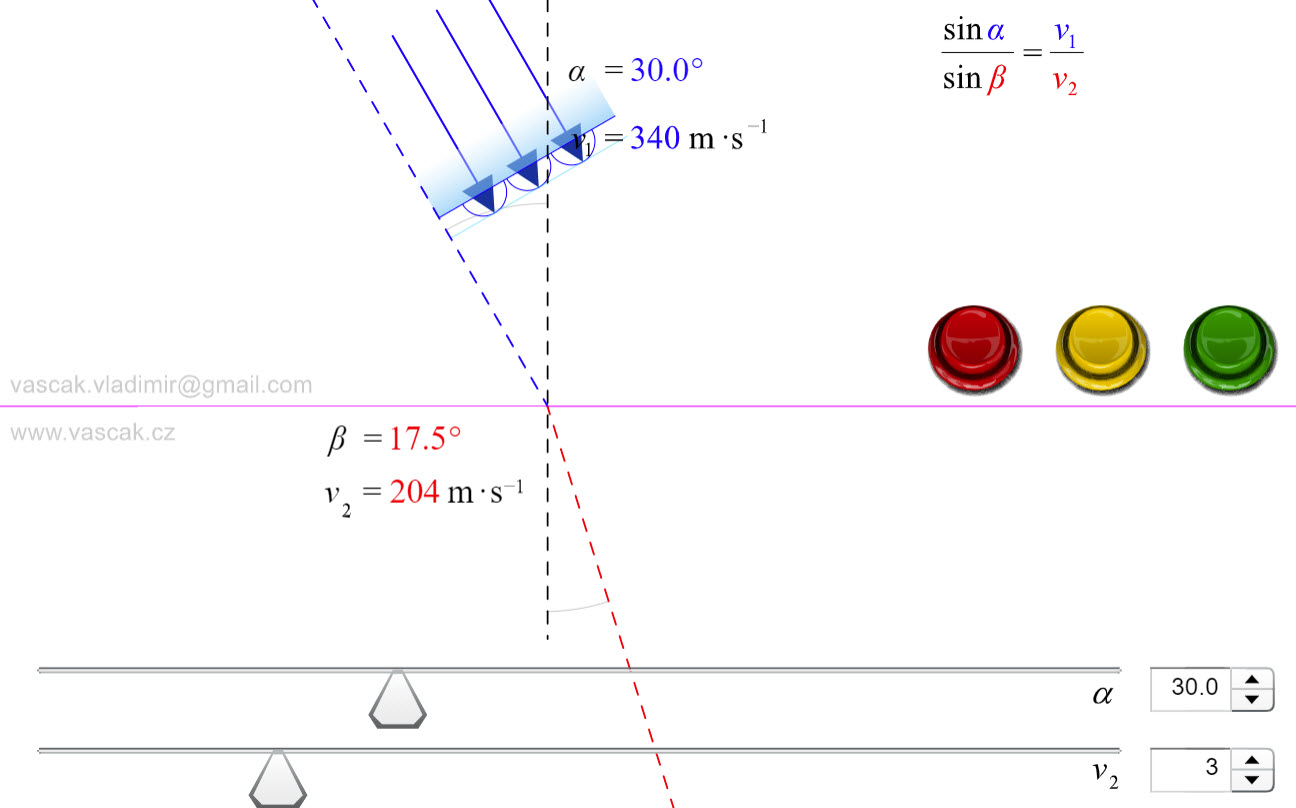 |
Great animation showing refraction at a surface and why the light rays change directions. |
| Snell's Law | 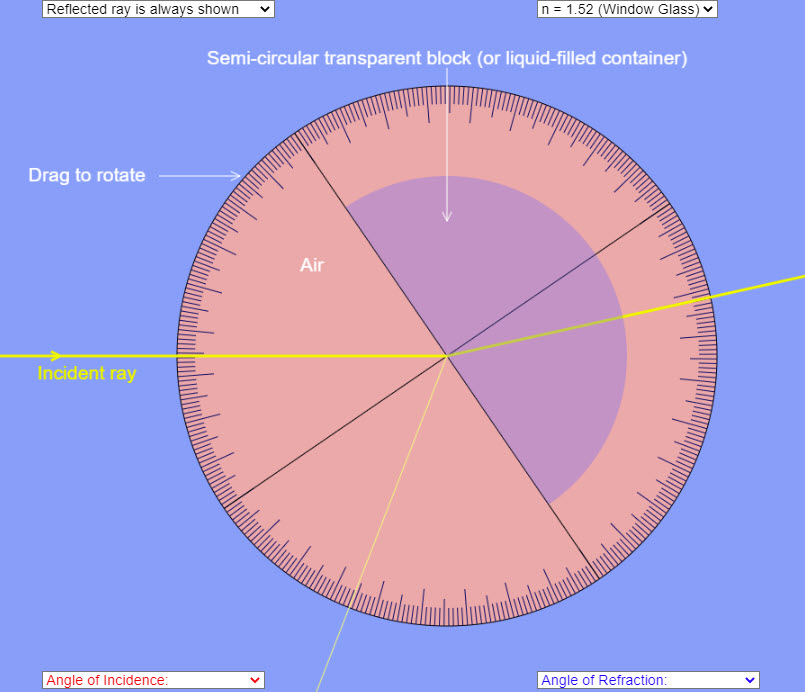 |
Simple animation showing Snell's Law. |
| Converging and Diverging Lenses | 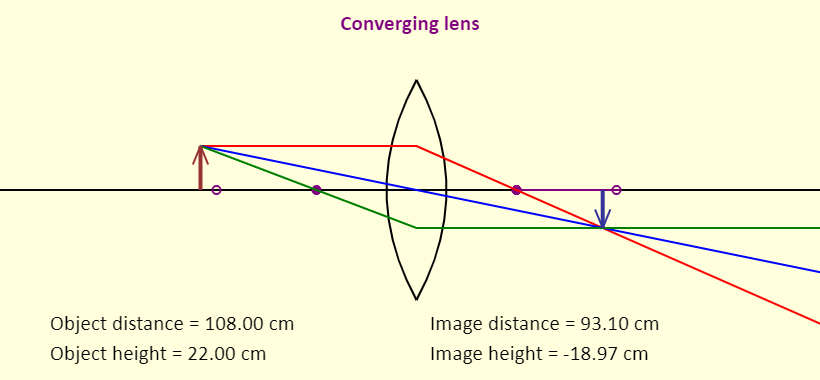 |
An outstanding applet showing the image formation by converging and diverging lenses. The applet shows the three principle rays for each diagram. |
| Image Formation by Converging Lenses | 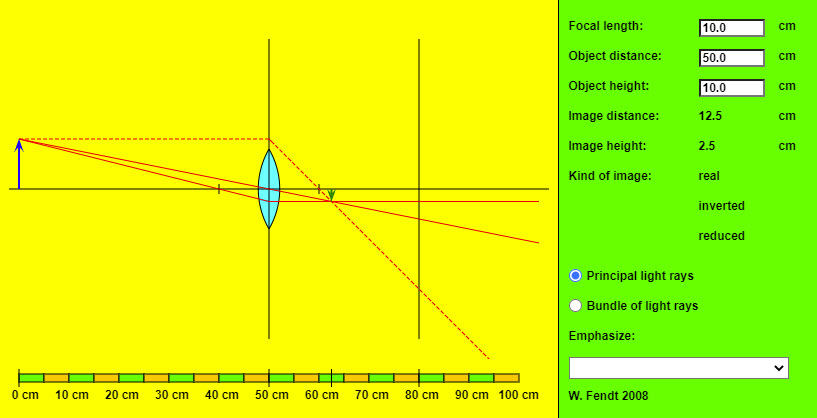 |
A nice applet showing the image formation by lenses and the three principle light rays. |
| The Lensmakers Equation | 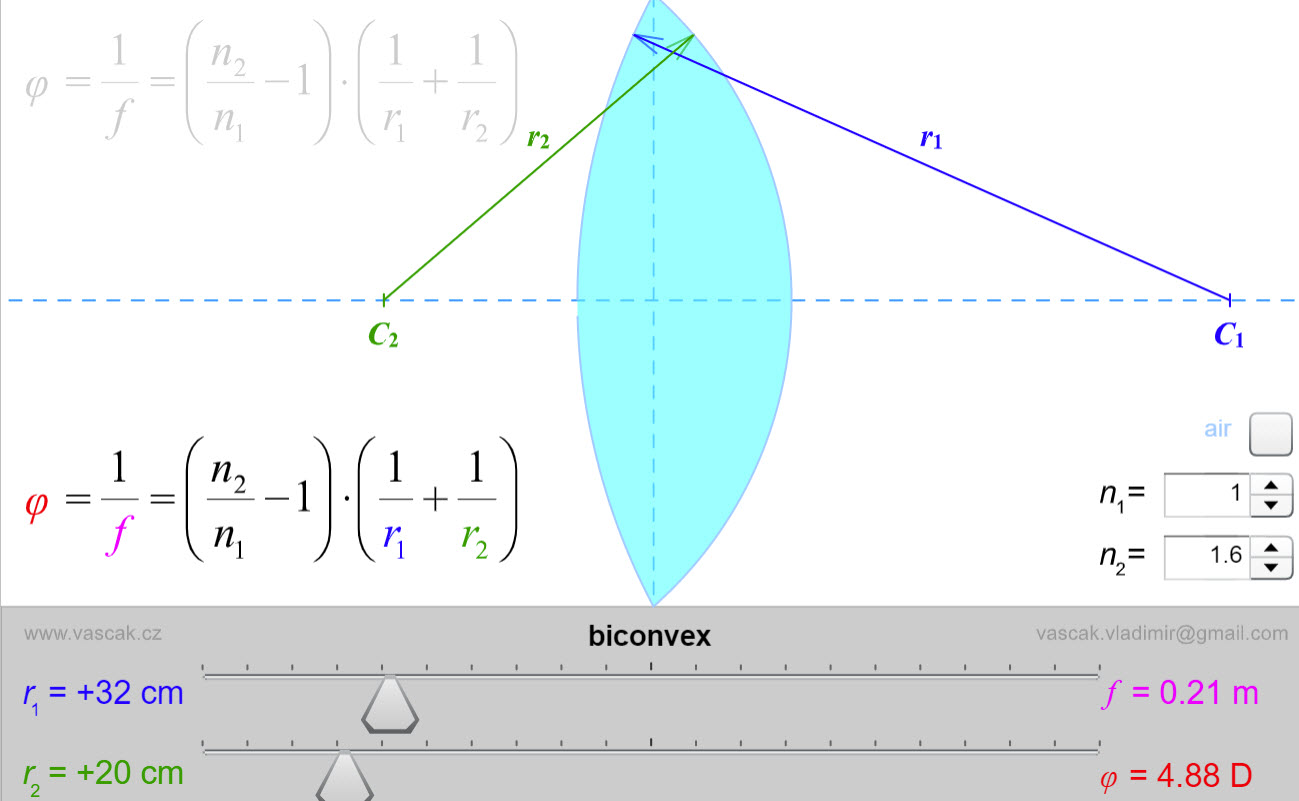 |
A nice animation demonstrating the Lensmaker's Equation and the different types of lenses. |
| Converging Lens | 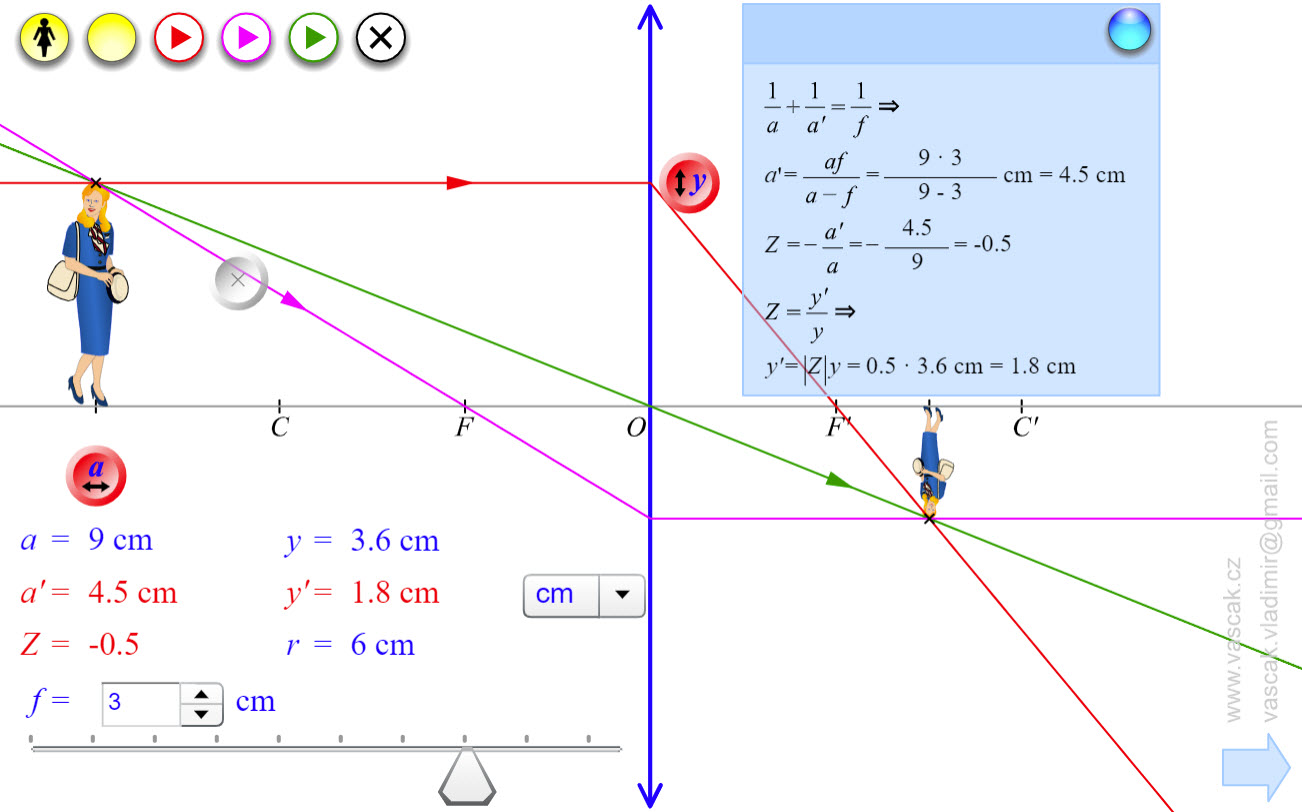 |
An outstanding applet showing the image formation by a converging lens and the three principle rays. |
| Diverging Lens | 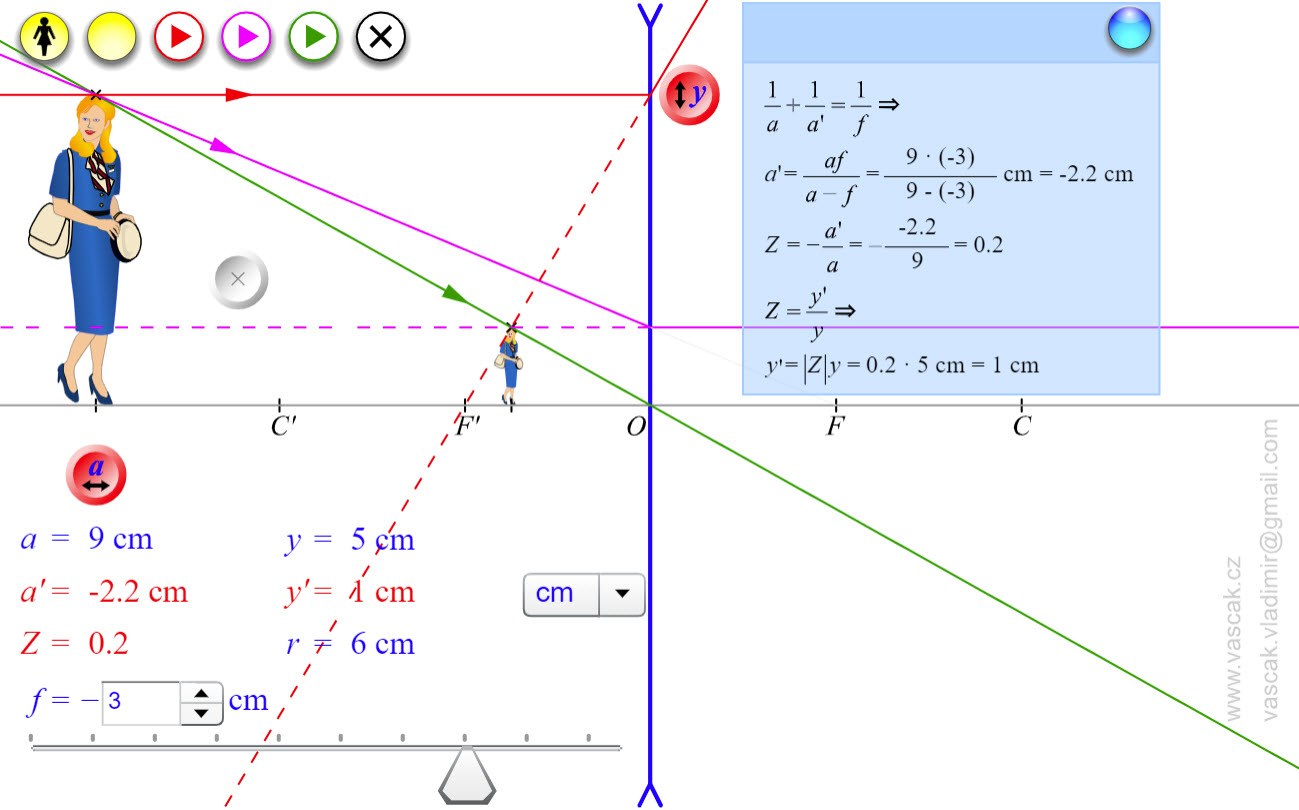 |
An outstanding applet showing the image formation by a diverging lens and the three principle rays. |
| Converging Lens Puzzle | 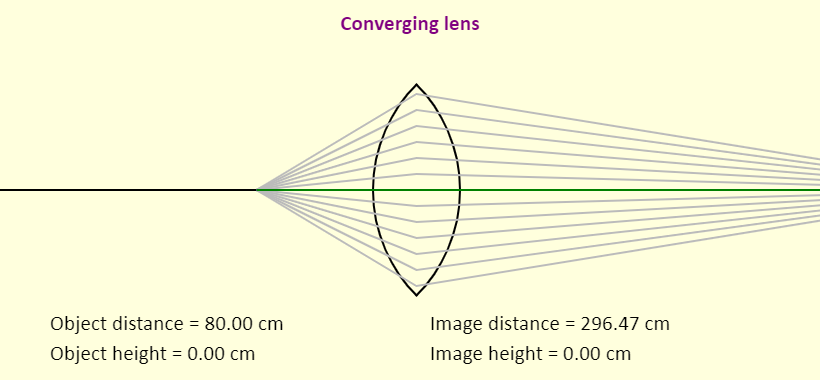 |
Determine the focal length of the lens. Try to find the focal length without doing a calculation. |
| What Kind of Lens is Behind the Orange Curtain? |  |
Test your familiarity with lenses. You can find the focal length of a converging or diverging lens by calculating it, but see if you can get to the point where you can find it without doing a calculation. |
| What Kind of Lens is Behind the Orange Curtain? |  |
Test your familiarity with lenses. You can find the focal length of a converging or diverging lens by calculating it, but see if you can get to the point where you can find it without doing a calculation. |
| What Kind of Lens is Behind the Orange Curtain? | 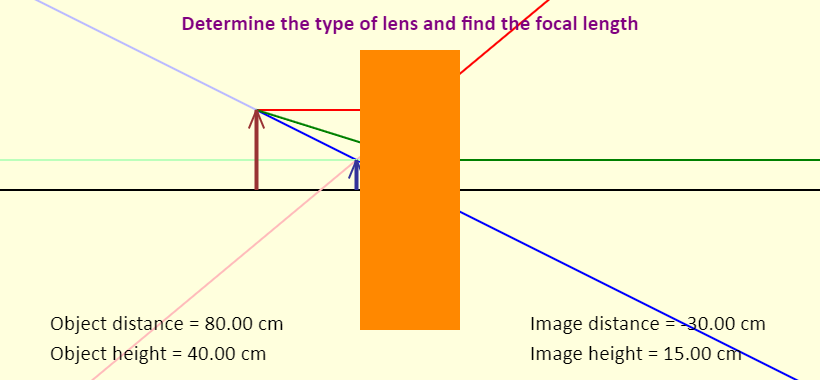 |
Test your familiarity with lenses. You can find the focal length of a converging or diverging lens by calculating it, but see if you can get to the point where you can find it without doing a calculation. |
| Prism |  |
This simulation demonstrates how a prism works. White light shines in from the left. You may be surprised to see that it goes straight into the prism, without splitting up inside the prism. Why is this? This is something of a special case. The light is split up into different colors when it emerges from the prism. This is because of the dispersion of the glass that the prism is made from. Dispersion means that the index of refraction varies depending on the wavelength of light - in general, the index of refraction of the glass increases as the wavelength of the light decreases. The net result is that light of smaller wavelengths experiences a larger change in direction when it emerges from the prism into the surrounding medium. Something odd seems to happen when the dispersion is high, the prism angle is large, and the medium surrounding the prism has a low index of refraction. Can you explain what is going on? |
| Prism | 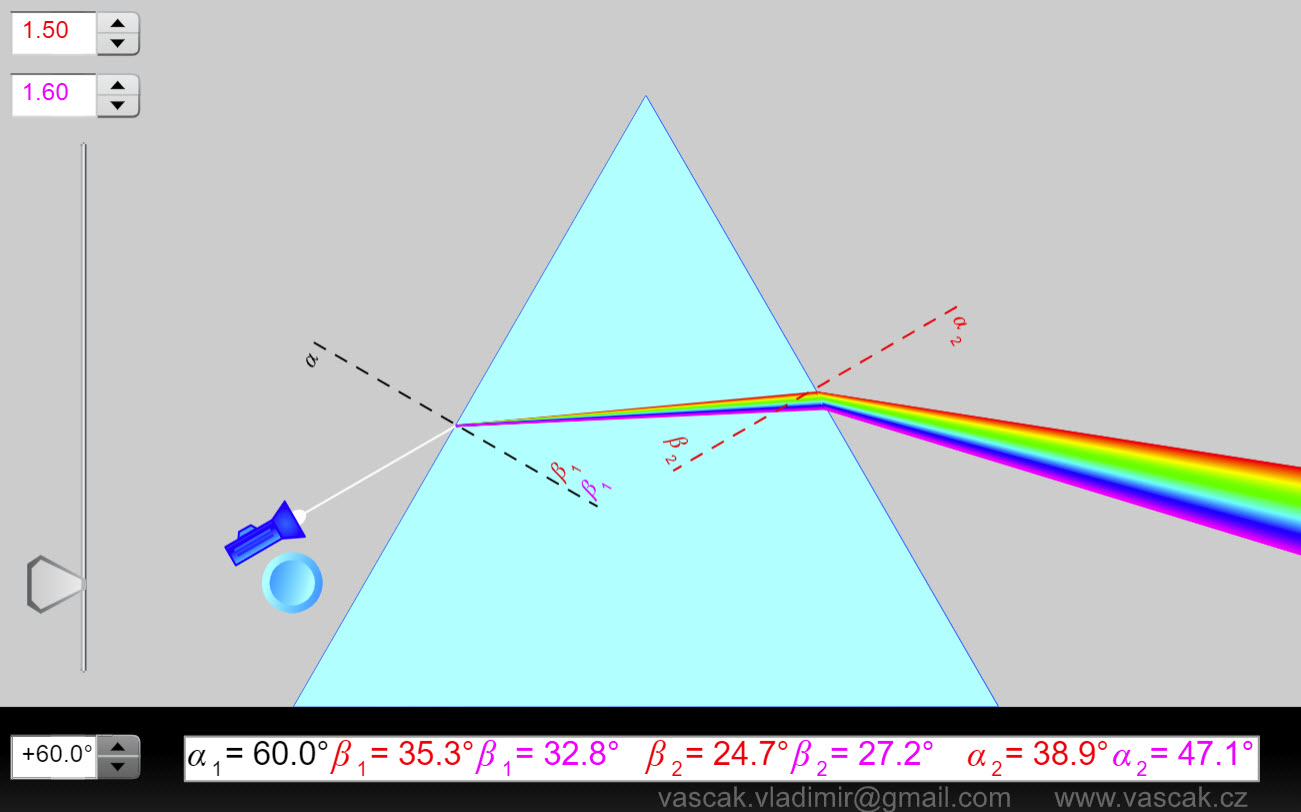 |
A simple animation showing refraction in a prism as well as dispersion. |
| Rainbow |  |
This is a representation of how a rainbow is formed - it is not drawn to scale. Refraction plays an important role - when white light from the Sun enters a droplet, it refracts into the droplet, experiences total internal reflection at the back of the droplet, and then refracts back out into the air. Because of dispersion (different wavelengths refract different amounts), different colors emerge in different directions. Looking at the single droplet, think about which color, red or violet, you expect to see highest in the sky. Then, switch to the two droplets, which gives a better perspective on what is happening - an eye is shown with both red light and violet light entering (the other colors of the visible spectrum would be in between red and violet). Note also that if you move your eye to a different position, you may get a different color entering your eye from the same droplet. This means that we all get our own personal rainbow. |
| Rainbow | 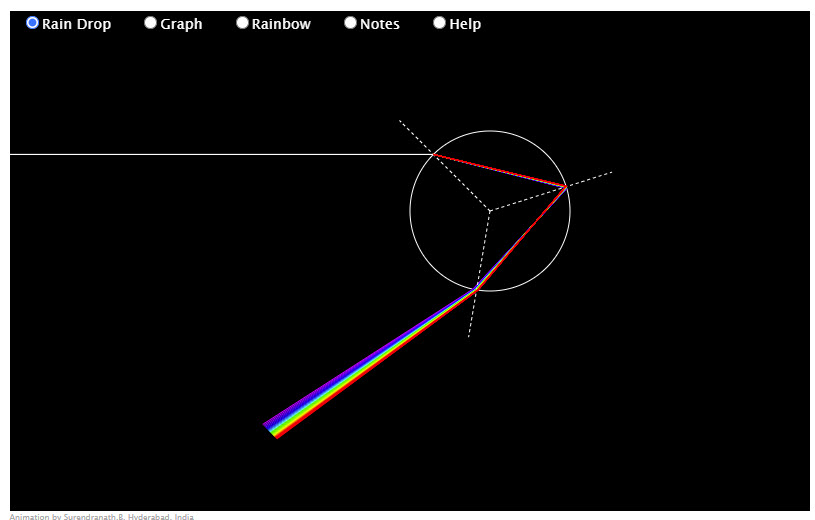 |
Illustration shows the passage of light through a rain drop. Of the several rays incident on the drop we are interested in the behavior of the rays that produce the primary rainbow and the secondary rainbow. Partial reflections and refractions occur at every point where the ray is incident but only relevant reflections and refractions are shown. Primary rainbow is due to the rays incident on the top portion of the drop and secondary rainbow is due to the rays incident on the bottom portion of the drop. The primary rainbow would be between angles of 40° and 42° to the horizontal and secondary rainbow between angles 51° and 53° to the horizontal. These are the rays that suffer minimum deviation as they are reflected and refracted and hence are brightest. In the graph option observe the way the deviation is measured. Observe the order of colors in the primary and secondary rainbows. |
| Total Internal Reflection | 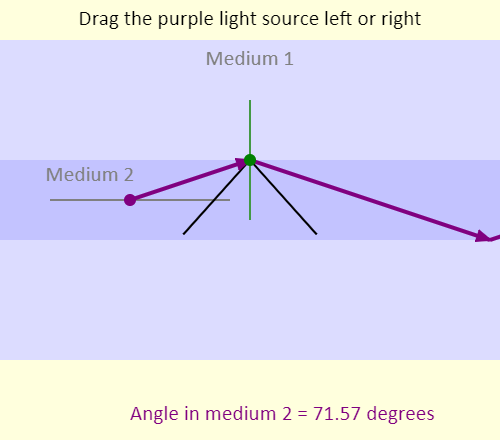 |
The light source is the purple dot in medium 2. The light is incident on the interface between the two media at the position of the green dot, which is fixed. The critical angle is marked by the angled black lines in one of the media. When the angle of incidence is less than or equal to the critical angle for that interface, some of the light reflects back into medium 2, and some refracts into medium 1. If the angle of incidence exceeds the critical angles, however, total internal reflection occurs, and the light remains in medium 2, bouncing off the interfaces as it proceeds along the medium. This is how an optical fiber works. This has many practical applications, ranging from the fiber optic cables that carry many of the internet signals around the world, to an endoscope, in which light is transmitted along an optical fiber, an an image of somewhere inside the human body is transmitted back. |